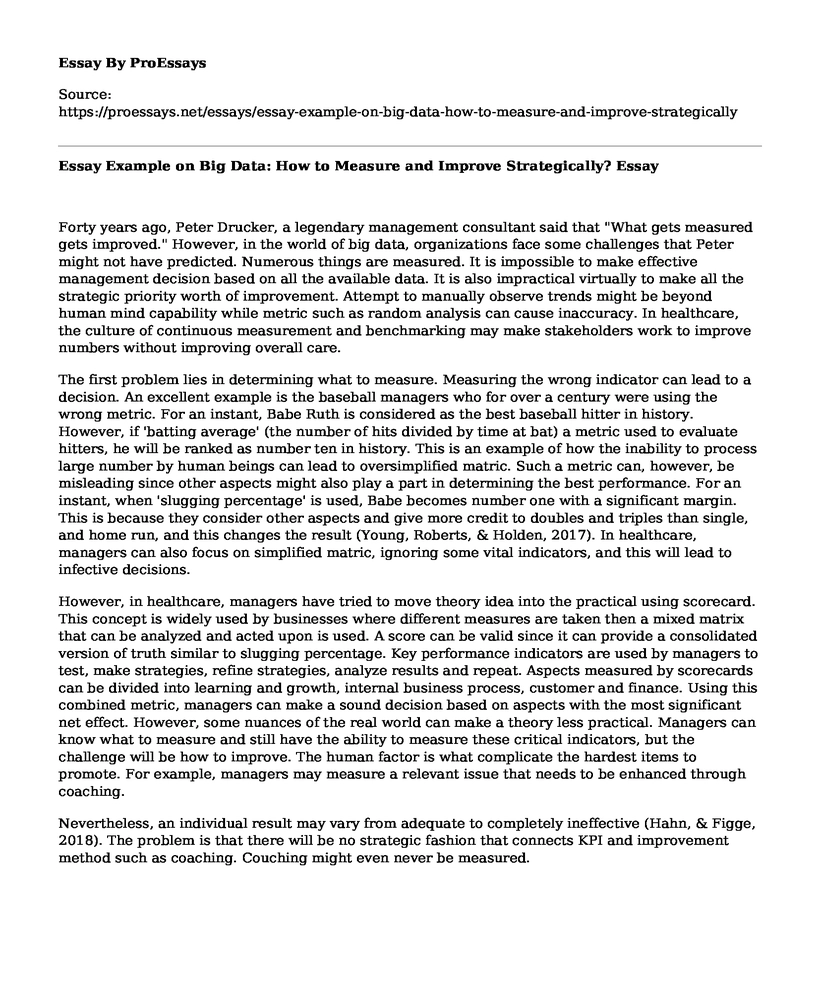Forty years ago, Peter Drucker, a legendary management consultant said that "What gets measured gets improved." However, in the world of big data, organizations face some challenges that Peter might not have predicted. Numerous things are measured. It is impossible to make effective management decision based on all the available data. It is also impractical virtually to make all the strategic priority worth of improvement. Attempt to manually observe trends might be beyond human mind capability while metric such as random analysis can cause inaccuracy. In healthcare, the culture of continuous measurement and benchmarking may make stakeholders work to improve numbers without improving overall care.
The first problem lies in determining what to measure. Measuring the wrong indicator can lead to a decision. An excellent example is the baseball managers who for over a century were using the wrong metric. For an instant, Babe Ruth is considered as the best baseball hitter in history. However, if 'batting average' (the number of hits divided by time at bat) a metric used to evaluate hitters, he will be ranked as number ten in history. This is an example of how the inability to process large number by human beings can lead to oversimplified matric. Such a metric can, however, be misleading since other aspects might also play a part in determining the best performance. For an instant, when 'slugging percentage' is used, Babe becomes number one with a significant margin. This is because they consider other aspects and give more credit to doubles and triples than single, and home run, and this changes the result (Young, Roberts, & Holden, 2017). In healthcare, managers can also focus on simplified matric, ignoring some vital indicators, and this will lead to infective decisions.
However, in healthcare, managers have tried to move theory idea into the practical using scorecard. This concept is widely used by businesses where different measures are taken then a mixed matrix that can be analyzed and acted upon is used. A score can be valid since it can provide a consolidated version of truth similar to slugging percentage. Key performance indicators are used by managers to test, make strategies, refine strategies, analyze results and repeat. Aspects measured by scorecards can be divided into learning and growth, internal business process, customer and finance. Using this combined metric, managers can make a sound decision based on aspects with the most significant net effect. However, some nuances of the real world can make a theory less practical. Managers can know what to measure and still have the ability to measure these critical indicators, but the challenge will be how to improve. The human factor is what complicate the hardest items to promote. For example, managers may measure a relevant issue that needs to be enhanced through coaching.
Nevertheless, an individual result may vary from adequate to completely ineffective (Hahn, & Figge, 2018). The problem is that there will be no strategic fashion that connects KPI and improvement method such as coaching. Couching might even never be measured.
Conclusion
To improve overall performance in health, the continuous measurement and benchmarking result should be put into best practice. Managers should first identify the best metric to measure KPIs. As it may, even after determining what to measure, they also need to connect KPIs with improvement strategies, primarily where the human factor is concerned. Without this, stakeholders will only improve numbers without improving overall care.
References
Ettorchi-Tardy, A., Levif, M., & Michel, P. (2017). Benchmarking: a method for continuous quality improvement in health. Healthcare policy, 7(4), e101.
Hahn, T., & Figge, F. (2018). Why architecture does not matter: On the fallacy of sustainability balanced scorecards. Journal of Business Ethics, 150(4), 919-935.
Young, R. A., Roberts, R. G., & Holden, R. J. (2017). The challenges of measuring, improving, and reporting quality in primary care. The Annals of Family Medicine, 15(2), 175-182.
Cite this page
Essay Example on Big Data: How to Measure and Improve Strategically?. (2023, Jul 24). Retrieved from https://proessays.net/essays/essay-example-on-big-data-how-to-measure-and-improve-strategically
If you are the original author of this essay and no longer wish to have it published on the ProEssays website, please click below to request its removal:
- Croatia Participation and Leadership in Tourism Organizations Essay
- Best Practices of Digital Portfolio
- Cost Behaviors in Toyota Case Study Paper Example
- Engaging Others in Leadership Paper Example
- Ethical and Moral Practices of Doing Business in Europe Paper Example
- Essay Example on Internet Addiction on Campus: A Growing Concern
- RoamAbout Hotel: Crafting an Incident Response Plan for Potential Cybersecurity Incidents - Essay Sample







